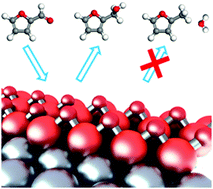DFT study of furfural conversion on a Re/Pt bimetallic surface: synergetic effect on the promotion of hydrodeoxygenation†
Abstract
Density functional theory (DFT) calculations of furfural conversion were performed via hydrogenation and hydrodeoxygenation pathways on a bimetallic surface, namely, a thin oxygen-covered Re film on Pt(111). In the most stable adsorption conformation, the furyl ring component adsorbs on the Re edge site and the carbonyl oxygen also plays an important role in the adsorption strength. It was found that, while furfural conversion is kinetically favoured in the hydrogenation route to generate furfuryl alcohol, the hydrodeoxygenation mechanism to generate 2-methylfuran and water is thermodynamically favoured. Our results show that the hydrodeoxygenation product 2-methylfuran is achievable via the hydrogenation of furfural into hydroxyalkyl species, followed by C–OH bond cleavage, and successive hydrogenations of the furyl–CH intermediate. However, the production of 2-methylfuran is prohibited as the oxidised Re surface cannot accept further oxygen deposition, due to the oxygen-related species are difficult to remove in the form of water via hydrogenation. By comparing the results from the Re/Pt system to those on a monometallic flat Pt surface, we were able to demonstrate that incorporation of the oxophilic metals to active metals for hydrogenation could promote the hydrodeoxygenation route by reducing the barrier of C–O bond cleavage.



 Please wait while we load your content...
Please wait while we load your content...